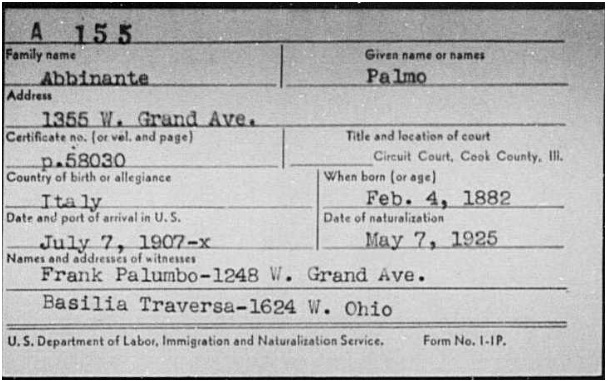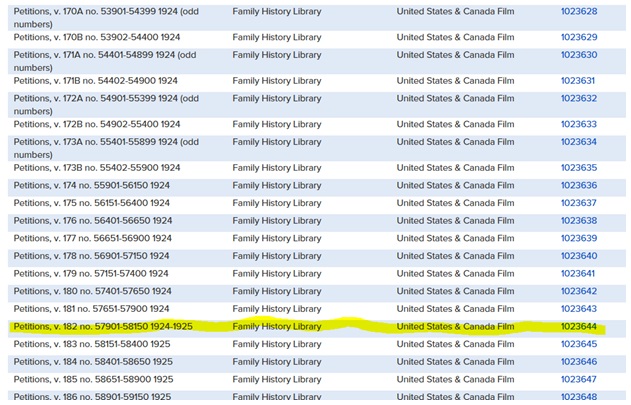Last month we learned how to find our ancestors’ applications to become United States Citizens. I would like to add some new information about the process first after spending the past month trying to find many distant relatives.
The only index on line is an index to the card file. This is what the card looks like:
The first critical piece of information we need is the “Title and location of court”. There are basically three choices here that cover 99% of the people in this index:
- US District
- Superior Court Cook County
- Circuit Court Cook County
A few of you might find other choices, such as “Lake County Illinois”, “Winnebago County Illinois” and other nearby locations. If you find one of those, you need to contact the clerk of that court, or go to the court web site to fill out the form to request copies of the papers they have on file.
Last month’s column focused on U.S. District courts, so I would like to add some information on working with the Cook County courts. As I mentioned last month, you can contact the clerk of those courts to request these documents. You can also order microfilm from a Family History Center a lot cheaper.
The example above is a Circuit Court naturalization, with Petition 58030 (as seen in the “Certificate no. (or vol. and page)” to the left of the court name. Circuit Court records have all been microfilmed but are not on-line. You have to look in the Family History Library catalog on www.familysearch.org to find the correct film number that contains the petition number you found on the index card, in this case 58030. Click here for a link directly to the Circuit Court microfilm list. You need to scroll down the list looking for a film that contains a range of petition numbers.
You can see the highlighted one contains 57901 through 58150. This is the film you need to get a copy of petition 58030. One more note: Look above and you can see “Petitions V. 170A no. 53901-54399” and “Petitions v. 170B no. 53902-54400”. For some reason, they have the odd numbered petition numbers on one film and the even numbered petitions on the other film. So if you were looking for petition 54370, you would need the film with even numbers. “53902-54400” contains the even numbered ones because the petition range listed shows two even numbers. If you needed 54369, you would use the film marked “53901-54399” because those two numbers are odd. If there is only one film number with the range containing your petition number, then that is the film. In other words, if there is no A or B in the volume number, then all petitions within that range of numbers are on that one film.
If you thought that was complicated, the Superior Court records are really weird. The index to those soundex cards lists Superior Court Cook County and a petition number, just like the Circuit Court and the U.S. District courts. However, the catalog entry for the Superior Court Petitions does not show a range of petition numbers, only volume number and page number. I am not sure why it is in the catalog like this, but it makes it near impossible to find the correct microfilm for your petition number. So my advice to you is to contact the Superior Court for copies of their petitions.
Ok, after all this pain, what do we find when we get there? Lots of great information. Click on the name of the document to see a sample.
- Certificate of arrival
- A small document listing the name of the ship, date of arrival in the US, port of arrival, and even the name they used (could be the maiden names of women even if they’re married) These were later incorporated onto the petition itself, including people who arrived in America by railroad or airplane.
- Declaration of Intention
- The declaration was a document filed by the “alien” declaring their intention to become a citizen. There would be a period of residency requirement before they could petition for naturalization, so the data on these papers is a few years older than the petition. This document lists the name and birth information, plus vital info such as height and weight, and “scars or marks” such as “scar on left cheekbone” or “missing index finger”.
It may list the name of the spouse, and some of the arrival information as well. If you are lucky and the declaration was filed in the late 1930s and early 1940s, there may be a photograph of the person attached to the declaration. Not every person has a declaration of intention, and these were abolished later on as redundant.
- Certificate of Loyalty or Examination
- During the war years, a separate letter was filed specifically saying that the person was of good character and deserved to be allowed to become a citizen.
- Affidavit in Support of Petition
- This is a document usually to use military service as the reason for bypassing other tests and admitting the petitioner.
- Petition for naturalization
- The petition has all vital data on the petitioner, plus the first name of their spouse, date and place of marriage, and a list of their living children, birthdates, and birthplaces of each child. They do not list stillbirths, or children who died before the petition was filed. There will be signatures of the two witnesses and the petitioner. There are never any photos on the petitions. These were added to the actual Certificate of Naturalization, which sadly are NOT in these films. Your ancestor may have kept theirs if you’re lucky.
- Oath of Allegiance
- Usually the second page of the petition has little more than the oath of allegiance. “I hereby renounce all loyalty to King Umberto I of Italy” etc etc.
There might also be a letter in the file that the person has repatriated back to their home country, and therefore their citizenship in the U.S. has been revoked.
The petitions after World War II are combined into one document and a lot of detail is no longer there. They might not list the children for a petitioner who was being naturalized in the 1960s or 1970s.
I need to comment on the accuracy of the data in these documents. The birthdates of the petitioner, spouse and children are accurate about half the time. The year of birth is often wrong by a year or two, perhaps due to the petitioner trying to avoid (or sign up for) military service. So do not be surprised if you find out that your dad was born a year earlier than you know. It may just be wrong on the document. Generally speaking, the later the petition, the more accurate the data is.
Petitions before 1906 are genealogically useless, because they don’t have the details that we want from the documents listed above. In 1906, the federal Government standardized the forms and you will typically find the same type of data and documents in a petition files in Washington state or New York or Texas as you do in Chicago.
If you have any questions, send me an email at italianroots@comcast.net and please put “Fra Noi” in the subject line. Have fun!
 Fra Noi Embrace Your Inner Italian
Fra Noi Embrace Your Inner Italian








